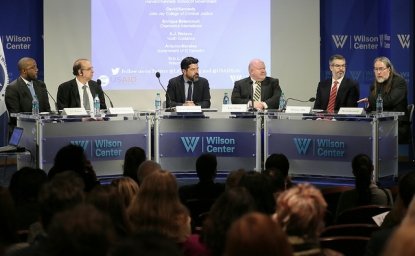The Wilson Center’s Latin American Program is pleased to launch a groundbreaking report from Harvard’s Kennedy School that identifies promising strategies for reducing community violence and suggests how evidenced-informed policy options might be adapted to high violence areas in Mexico and Central America. The past decade has not been kind to Mexico and Central America. Homicides and violent assaults have skyrocketed, making parts of Mexico and swaths of Central America’s Northern Triangle — El Salvador, Guatemala, and Honduras — among the most violent in the world. El Salvador’s homicide rate reached 103 per 100,000 inhabitants in 2015, and its capital of San Salvador has been cited as the most homicidal city in the world. Mexico experienced the first increase in homicides (11 percent) since its peak in 2011. By U.N. standards, homicides have reached epidemic proportions in several Mexican states and all three Northern Triangle countries. The violence is often blamed on transnational organized crime and vicious drug and youth gangs that, at times, resort to shockingly violent acts to intimidate and send a message to rivals and the authorities. There also exists a perhaps more insidious problem at the local level: astronomically high levels of community and household violence. These interrelated and mutually reinforcing kinds of violence — household, communal, gang, and organized— have disastrous consequences for individuals and communities in Mexico and the Northern Triangle. Citizens have little faith that authorities can or will protect them, and often feel law enforcement agents are complicit in criminal activity and violence. Terrified, they are forced to flee, retreat to avoid violence, form citizen militias to push back, or join criminal networks as the only source of relative safety. Governments are often at a loss for how to respond. Many respond by targeting kingpins, drug lords, and criminal leaders. Others have taken a “tough on crime” approach by targeting gang members and entire violent communities, thereby significantly increasing the number of people incarcerated. While alternatives to hardline security measures emphasizing prevention and rehabilitation are gaining ground in the region, government responses in most cases continue to prioritize law enforcement solutions. Yet these approaches alone have seldom brought about a lasting reduction in violence.
In this context, the Wilson Center’s Latin American Program is pleased to present a major new study conducted by a team of researchers from Harvard’s Kennedy School that reviews dozens of experiences in reducing violence. This groundbreaking report, entitled “What Works’ in Reducing Community Violence: A Meta-Review and Field Study for the Northern Triangle,” was commissioned by the United States Agency for International Development. It examines 43 reviews of over 2,200 studies of what works in community violence reduction. The study offers a complex story about what can be done to reduce community level violence but offers two important findings:
- “…crime is concentrated at a small number of high-risk places during high-risk times and generate by a small number of very risky people” (Braga, 2015); and,
- “Crime should be analyzed in multiple units, or categories, including offenders, criminal networks, victims, micro-places (hot spots), communities, times, days of the week, and other categories.” (Sherman, 2012).
Two strategies held particular promise based on the reviews. The first is focused deterrence, which targets specific violent individuals within a community by mobilizing law enforcement, social services, and community stakeholders to engage in direct, repeated communication with offenders to stop violence. This strategy has by far the greatest direct impact on community violence of any intervention described in the report, with homicide reductions ranging from 34 percent to 63 percent. Another promising strategy is cognitive behavioral therapy (CBT), which uses clinical psychology techniques to address the unhealthy thought patterns characteristic of criminal and juvenile offenders. CBT was associated with a 25 percent to 52 percent decrease in recidivism. The elements of success include:
- Specificity: Target interventions to the people, places, and behaviors that are most at risk for violence
- Proactivity: Prevent violence before it occurs whenever possible by engaging with high-risk populations
- Legitimacy: Create a mechanism for feedback between formal and informal sectors involved in the intervention
- Theory: Establish a well-defined theory of how the intervention will change rates of violence
Authors

Director of Policy and Strategic Initiatives, Seattle International Foundation

Latin America Program
The Wilson Center’s prestigious Latin America Program provides non-partisan expertise to a broad community of decision makers in the United States and Latin America on critical policy issues facing the Hemisphere. The Program provides insightful and actionable research for policymakers, private sector leaders, journalists, and public intellectuals in the United States and Latin America. To bridge the gap between scholarship and policy action, it fosters new inquiry, sponsors high-level public and private meetings among multiple stakeholders, and explores policy options to improve outcomes for citizens throughout the Americas. Drawing on the Wilson Center’s strength as the nation’s key non-partisan policy forum, the Program serves as a trusted source of analysis and a vital point of contact between the worlds of scholarship and action. Read more


Mexico Institute
The Mexico Institute seeks to improve understanding, communication, and cooperation between Mexico and the United States by promoting original research, encouraging public discussion, and proposing policy options for enhancing the bilateral relationship. A binational Advisory Board, chaired by Luis Téllez and Earl Anthony Wayne, oversees the work of the Mexico Institute. Read more




